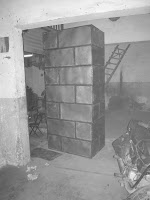

CP-1 was buried in nearby woodland, this was not a fortuitous beginning to the issue of dealing with nuclear waste.
I had originally intended the installation to be about order and chaos but the imperfection of the cubes has led it elsewhere. I like the lack of perfection in theses boxes, distorted by the heat of their making. The imperfection of these (not so) minimal cubes echoes the story of the black stone of the Kaaba.

"Base of the World, Magic Base No. 3 by Piero Manzoni 1961 Homage to Galileo."
The world as sculpture.
Mona Hatoum, "Socle du Monde" 1992-1993
Wooden structure, steel plates, magnets and iron fillings
64 5/8 x 78 3/4 x 78 3/4 in. (164 x 200 x 200 cm)
Photo: Edward Woodman
Besides a tribute to Manzoni's sculpture by the same name of 1961, Hatoum says like the black stone of the Kaaba, thirty years of wars and deceits have turned Manzoni's pure work black with the sins of man.
"12.2.42"
I see "12.2.42" as part tribute (to scientific endeavor) and part warning (of the imperfect nature of mankind's knowledge). The smallness of mankind's achievements set against the vastness of creation. The ultimate failure of all technologies and even civilization itself. It is a Vanitas sculpture. It critiques the arrogance of scientific knowledge. I half suspect this world will be sucked through the eye of an atom sized black-hole, produced in the new Cern accelerator. What a suitable end it would be for this planet, wrecked as it is, by mankind's insatiable greed.
"A Taxonomy of Eden"
“Now the LORD God had planted a garden in the east, in
Genesis 2:8 9
In the Bible, God tells the man to name the animals (Genesis
I propose that Hazrat Adam made botanical labels for Eden, having learnt of all the names of the plants from God. Unfortunately many of these names are embedded with tales of Empire, the names of Victorian naturalists, indigenous names latinized and other slight problems in the overall scheme of things. I was thinking I might add zoological names plates for the reptilian and mammalian inhabitants of Eden, at least a few key characters. This is still under consideration.
Finding convincing and possible names for the plants of Eden is a longer task. I've started researching Quaranic and biblical references, but they then need re-translating into botanical Latin, it's going to take some time. I will then commission engraved labels, which I will in turn photograph. I am hoping to do one garden work for the NCA show, by 14th. February 2009. This will be a grid of botanical labels, in place of a garden. "All the Names" (re. Samarago's book) or "The Naming of Names" (re. Anna Parvord's book) may be title options. This will work alongside the file (Record Room) images. I will combine photographs of botanical labels from multiple locations, the regional languages also impinge in this supposedly international language of science. The labels are grey and the assemblage feels like a mausoleum. This also serves as a pointer to environmental issues, as so many plant names may survive the species (in the wild) in many cases.




No comments:
Post a Comment